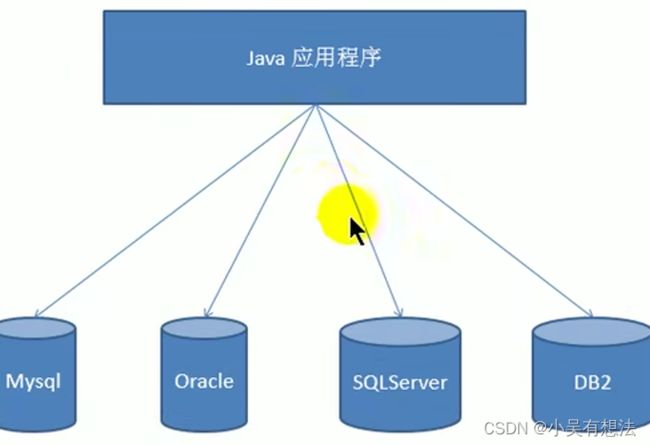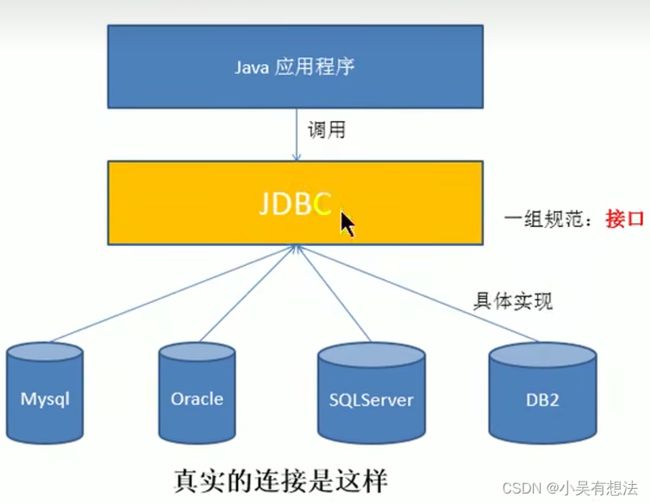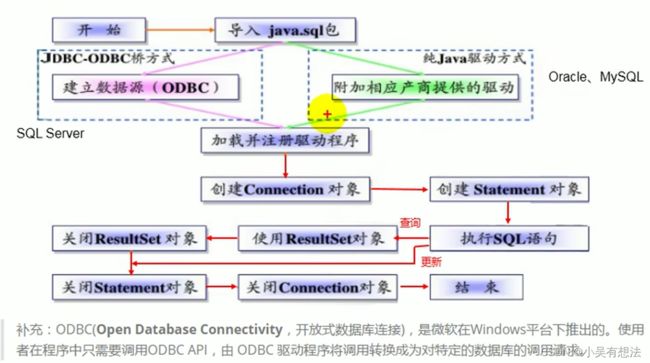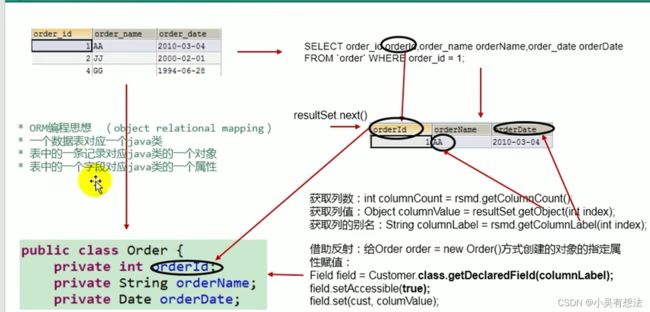JDBC视频学习笔记
学习视频:尚硅谷JDBC核心技术视频教程(康师傅带你一站式搞定jdbc)_哔哩哔哩_bilibili
目录
JDBC概述
1.1 数据的持久化
1.2 Java中的数据存储技术
1.3 JDBC介绍
1.4 JDBC体系结构
1.5 JDBC程序编写步骤
获取数据库连接
2.1:Driver 接口实现类
2.1.1 Driver接口介绍
2.2:URL
2.3获取数据库连接的方式
获取数据库连接的方式一:
获取数据库连接的方式二:
获取数据库连接的方式三:
获取数据库连接方式四:
获取数据库连接方式五
3.操作数据表
3.1使用Statement操作数据表的弊端
3.2 PreparedStatement实现表数据的添加操作
3.3 封装数据库连接和关闭操作
3.4PreparedStatement实现表数据的修改操作
3.5 PreparedStatement实现通用的增删改操作
3.6 针对t_user表的查询操作举例
3.7 针对t_user表的通用的查询操作
3.8 图解查询操作的流程
JDBC概述
1.1 数据的持久化
- 持久化(persistence):把数据保存到可掉电式存储设备中以供之后使用,大多数情况下,特别是企业级应用,数据持久化意味着将内存中的数据保存到硬盘上加以"固化",而持久化的实现过程大多通过各种关系数据库来完成。
- 持久化的主要应用是将内存中的数据存储在关系型数据库中,当然也可以存储在磁盘文件、XML数据文件中。
1.2 Java中的数据存储技术
- 在java中,数据库存取技术可分为如下几类:
- JDBC直接访问数据库
- JDO(Java Data Object )技术
- 第三方O/R工具,如Hibernate,Mybatis 等
- JDBC是java访问数据库的基石,JDO、Hibernate、MyBatis等只是更好的封装了JDBC
1.3 JDBC介绍
- JDBC(Java Database Connectivity)是一个独立于特定数据库管理系统、通用的SQL数据库存取和操作的公共接口(一组API),定义了用来访问数据的标准java类库,(java.sql,javax.sql)使用这些类库可以以一种标准的方法、方便地访问数据库资源。
- JDBC为访问不同的数据库提供了一种统一的途径,为开发者屏蔽了一些细节问题。
- JDBC的目标是使java程序员使用JDBC可以连接任何提供了JDBC驱动程序的数据库系统,这样就使得程序员无需对特定的数据库系统的特点有过多的了解,从而大大简化和加快了开发过程。
- 如果没有JDBC,那么java程序访问数据库时是这样的:

- 有了JDBC,Java程序访问数据库时是这样的:

1.4 JDBC体系结构
- JDBC接口(API)包括两个层次:
- 面向应用的API:java API,抽象接口,供应用程序开发人员使用(连接数据库,执行SQL语句,获得结果).
- 面向数据库的API:Java Driver API ,供开发商开发数据库驱动程序使用。
JDBC是sun公司提供一套用于数据库操作的接口,java程序员只需要面向这套接口编程即可。不同的数据库厂商,需要针对这套接口,提供不同的实现。不同的实现的集合,即为不同数据库的驱动。 --------面向接口编程
1.5 JDBC程序编写步骤
获取数据库连接
2.1:Driver 接口实现类
2.1.1 Driver接口介绍
- java.sql.Driver 接口是所有JDBC 驱动程序需要实现的接口, 这个接口是提供给数据库厂商使用的,不同数据库厂商提供不同的实现。
- 在程序中不需要直接去访问实现了Driver接口的类,而是由驱动程序管理器类(java.sql.DriverManager)去调用这些Driver实现。
- Oracle的驱动:oracle.jdbc.driver.OracleDriver
- mySql的驱动:com.mysql.jdbc.Driver
2.2:URL
-
JDBC URL 用于标识一个被注册的驱动程序,驱动程序管理器通过这个 URL选择正确的驱动程序,从而建立到数据库的连接。
-
JDBC URL 的标准由三部分组成,各部分间用冒号分隔。
-
jdbc:子协议:子名称
-
协议:JDBC URL 中的协议总是jdbc
-
子协议: 子协议用于标识一个数据库驱动程序
-
子名称: 一种标识数据库的方法。子名称可以依不同的子协议而变化,用子名称的目的是为了定位数据库提供足够的信息。包含主机名(对应服务端的ip地址),端口号,数据库名
-
- 举例:
- 几种常用数据库的 JDBC URL
- MySQL的连接URL编写方式:
- jdbc:mysql://主机名称:mysql服务端口号/数据库名称?参数=值&参数=值
- jdbc:mysql://localhost:3306/wc
- MySQL的连接URL编写方式:
2.3获取数据库连接的方式
获取数据库连接的方式一:
package com.wc.connection;
import java.sql.Connection;
import java.sql.Driver;
import java.sql.SQLException;
import java.util.Properties;
import org.junit.Test;
public class ConnectionTest {
@Test
public void testConnection1() throws SQLException{
Driver driver=new com.mysql.cj.jdbc.Driver();
/*
jdbc:mysql 协议
localhost ip地址
3306 默认mysql的端口号
db_book1 db_book1数据库
*/
String url="jdbc:mysql://localhost:3306/db_book1?serverTimezone=GMT%2B8";
//将用户名和密码封装在Properties中
Properties info=new Properties();
info.setProperty("user","root");
info.setProperty("password","root");
Connection conn=driver.connect(url,info);
System.out.println(conn);
}
}
获取数据库连接的方式二:
// 方式二:对方式一的迭代 :在如下的过程中不出现第三方的API,使得程序具有更好的可移植性
@Test
public void testConnection2() throws Exception
{
//1.获取Driver实现类对象:使用反射
Class clazz=Class.forName("com.mysql.cj.jdbc.Driver");
Driver driver=(Driver)clazz.newInstance();
//2.提供要连接的数据库
String url="jdbc:mysql://localhost:3306/db_book1?serverTimezone=GMT%2B8";
//3.提供连接需要的用户名和密码
Properties info=new Properties();
info.setProperty("user","root");
info.setProperty("password","root");
//4.获取连接
Connection conn= driver.connect(url,info);
System.out.println(conn);
}获取数据库连接的方式三:
//方式三:使用DriverManager替换Driver
@Test
public void testConnection() throws Exception
{
//1.获取Driver实现类的对象
Class clazz=Class.forName("com.mysql.cj.jdbc.Driver");
Driver driver=(Driver)clazz.newInstance();
//2.提供另外三个连接的基本信息
String url="jdbc:mysql://localhost:3306/db_book1?serverTimezone=GMT%2B8";
String user="root";
String password="root";
//注册驱动
DriverManager.registerDriver(driver);
//获取连接
Connection conn= DriverManager.getConnection(url,user,password);
System.out.println(conn);
}获取数据库连接方式四:
@Test
public void testConnection4() throws Exception {
//1.提供另外三个连接的基本信息
String url = "jdbc:mysql://localhost:3306/db_book1?serverTimezone=GMT%2B8";
String user = "root";
String password = "root";
//2.获取Driver实现类的对象
Class.forName("com.mysql.cj.jdbc.Driver");
/*
在mysql的Driver实现类中,声明了如下的操作:
static {
try {
java.sql.DriverManager.registerDriver(new Driver());
} catch (SQLException E) {
throw new RuntimeException("Can't register driver!");
}
}
*/
//获取连接
Connection conn = DriverManager.getConnection(url, user, password);
System.out.println(conn);
}获取数据库连接方式五
//方式五(final版):将数据库连接需要的4个基本信息声明在配置文件中,通过读取配置文件的方式,获取连接
/*
此方式的好处:
1.实现了数据与代码的分离,实现了解耦
2.如果需要修改配置文件信息,可以避免重新打包
*/
@Test
public void getConnection5() throws Exception
{
//1.读取配置文件中的4个基本信息
InputStream is = ConnectionTest.class.getClassLoader().getResourceAsStream("jdbc.properties");
Properties pros=new Properties();
pros.load(is);
String user= pros.getProperty("user");
String password= pros.getProperty("password");
String url= pros.getProperty("url");
String driverClass=pros.getProperty("driverClass");
//2.加载驱动
Class.forName(driverClass);
//3.获取连接
Connection conn = DriverManager.getConnection(url,user,password);
System.out.println(conn);
}3.操作数据表
3.1使用Statement操作数据表的弊端
- Statement 接口中定义了下列方法用于执行SQL语句
- int excuteUpdate(String sql):执行更新操作INSERT ,UPDATE ,DELETE
- ResultSet executeQuery(String sql):执行查询操作SELECT
- 但是使用Statement操作数据表存在弊端:
- 存在拼串操作,繁琐
- 存在SQL注入问题
- SQL注入是利用某些系统没有对用户输入的数据进行充分的检查,而在用户输入数据中注入非法的SQL语句段或命令(如:SELECT user,password FROM user WHERE user='a' OR 1='AND password='OR'1'='1'),从而利用系统的SQL引擎完成恶意行为的做法。
3.2 PreparedStatement实现表数据的添加操作
package com.wc.preparedstatement;
import com.wc.connection.ConnectionTest;
import org.junit.Test;
import java.io.IOException;
import java.io.InputStream;
import java.sql.*;
import java.util.Properties;
/*
使用PreparedStatement来替换Statement,实现对数据表的增删改查操作
增删改;查
*/
public class PreparedStatementUpdateTest {
//向t_user表中添加一条记录
@Test
public void testInsert()//涉及到资源的关闭,这边就不throws了,用try catch
{
Connection conn = null;
PreparedStatement ps= null;
try {
//1.读取配置文件中的4个基本信息
InputStream is = ConnectionTest.class.getClassLoader().getResourceAsStream("jdbc.properties");
Properties pros=new Properties();
pros.load(is);
String user= pros.getProperty("user");
String password= pros.getProperty("password");
String url= pros.getProperty("url");
String driverClass=pros.getProperty("driverClass");
//2.加载驱动
Class.forName(driverClass);
//3.获取连接
conn = DriverManager.getConnection(url,user,password);
// System.out.println(conn);
//4.预编译sql语句,返回PrepareStatement的实例
String sql="insert into t_user(userName,password)values(?,?)";
ps = conn.prepareStatement(sql);
//5.填充占位符
ps.setString(1,"xx");
ps.setInt(2,11111);
//6.执行sql
ps.execute();
} catch (Exception e) {
e.printStackTrace();
} finally {
//7.资源的关闭
try {
if(ps!=null)
ps.close();
} catch (SQLException e) {
e.printStackTrace();
}
try {
if(conn!=null)
conn.close();
} catch (SQLException e) {
e.printStackTrace();
}
}
}
}
3.3 封装数据库连接和关闭操作
package wc3;
import com.wc.connection.ConnectionTest;
import java.io.InputStream;
import java.sql.Connection;
import java.sql.DriverManager;
import java.sql.PreparedStatement;
import java.sql.SQLException;
import java.util.Properties;
public class JDBCUtils {
public static Connection getConnection() throws Exception
{
//1.读取配置文件中的4个基本信息
InputStream is = ClassLoader.getSystemClassLoader().getResourceAsStream("jdbc.properties");
Properties pros=new Properties();
pros.load(is);
String user= pros.getProperty("user");
String password= pros.getProperty("password");
String url= pros.getProperty("url");
String driverClass=pros.getProperty("driverClass");
//2.加载驱动
Class.forName(driverClass);
//3.获取连接
Connection conn = DriverManager.getConnection(url,user,password);
return conn;
}
public static void closeResource(Connection conn, Statement ps)
{
//7.资源的关闭
try {
if(ps!=null)
ps.close();
} catch (SQLException e) {
e.printStackTrace();
}
try {
if(conn!=null)
conn.close();
} catch (SQLException e) {
e.printStackTrace();
}
}
}
3.4PreparedStatement实现表数据的修改操作
//修改t_user表的一條記錄
@Test
public void testUpdate()
{
Connection conn= null;
PreparedStatement ps= null;
try {
//1.獲取數據庫的連接
conn = JDBCUtils.getConnection();
//2.預編譯sql語句,返回PreparedStatement的實例
String sql="update t_user set userName=? where id=?";
ps = conn.prepareStatement(sql);
//3.填充佔位符
ps.setString(1,"xy");
ps.setInt(2,4);
//4.執行
ps.execute();
} catch (Exception e) {
e.printStackTrace();
} finally {
//5.資源的關閉
JDBCUtils.closeResource(conn,ps);
}
}
3.5 PreparedStatement实现通用的增删改操作
@Test
public void testCommonUpdate()
{
String sql="delete from t_user where id=?";
update(sql,4);
}
//通用的增刪改操作
public void update(String sql,Object ...args) //sql中佔位符的個數與可變形參的長度相同
{
Connection conn= null;
PreparedStatement ps= null;
try {
conn = JDBCUtils.getConnection();
//預編譯
ps = conn.prepareStatement(sql);
//填充佔位符
for(int i=0;i3.6 针对t_user表的查询操作举例
package com.wc.preparedstatement;
import bean.t_user;
import org.junit.Test;
import wc3.JDBCUtils;
import java.sql.Connection;
import java.sql.PreparedStatement;
import java.sql.ResultSet;
import java.sql.ResultSetMetaData;
public class t_userForQuery {
@Test
public void testQuery1()
{
Connection conn= null;
PreparedStatement ps= null;
ResultSet resultSet= null;
try {
conn = JDBCUtils.getConnection();
String sql="select * from t_user where id=?";
ps = conn.prepareStatement(sql);
ps.setObject(1,1);
//執行,並返回結果集
resultSet = ps.executeQuery();
//處理結果集
if(resultSet.next())//判斷結果集的下一條是否有數據,如果有返回true,并指針下移,如果返回false,指針不会下移
{
//获取当前这条数据的各个字段值
int id=resultSet.getInt(1);
String userName=resultSet.getString(2);
int password =resultSet.getInt(3);
System.out.println("id="+id+",userName= "+userName+",password= "+password);
// Object[] data=new Object[]{id,userName,password};
//将数据封装为一个对象
// t_user t1=new t_user(id,userName,password);
// System.out.println(t1);
}
} catch (Exception e) {
e.printStackTrace();
} finally {
//关闭资源
JDBCUtils.closeResource(conn,ps, resultSet);
}
}
}
public static void closeResource(Connection conn, Statement ps,ResultSet rs )
{
try {
if(ps!=null)
ps.close();
} catch (SQLException e) {
e.printStackTrace();
}
try {
if(conn!=null)
conn.close();
} catch (SQLException e) {
e.printStackTrace();
}
try {
if(rs!=null)
rs.close();
} catch (SQLException e) {
e.printStackTrace();
}
}
package bean;
/*
ORM編程思想:(object relational mapping)
一个数据表对应一个java类
表中的一个记录对应java类的一个对象
表中的一个字段对应java类的一个属性
*/
public class t_user {
private int id;
private String userName;
private String password;
public t_user() {
}
public t_user(int id, String userName, String password) {
this.id = id;
this.userName = userName;
this.password = password;
}
public int getId() {
return id;
}
public void setId(int id) {
this.id = id;
}
public String getUserName() {
return userName;
}
public void setUserName(String userName) {
this.userName = userName;
}
public String getPassword() {
return password;
}
public void setPassword(String password) {
this.password = password;
}
@Override
public String toString() {
return "t_user{" +
"id=" + id +
", userName='" + userName + '\'' +
", password=" + password +
'}';
}
}
3.7 针对t_user表的通用的查询操作
@Test
public void testqueryFort_user()
{
String sql="select * from t_user where id=?";
t_user ts=queryFort_users(sql,2);
System.out.println(ts);
}
public t_user queryFort_users(String sql,Object ...args)
{
Connection conn= null;
PreparedStatement ps= null;
ResultSet rs= null;
try {
conn = JDBCUtils.getConnection();
ps = conn.prepareStatement(sql);
for(int i=0;i3.8 图解查询操作的流程
注: .execute()
如果执行的是查询操作,有返回结果,则此方法返回true
如果执行的是增删改操作,没返回结果,则此方法返回false
现在欠的东西太多啦,希望不挂科呗
以上为观看尚硅谷视频学习笔记,如有侵权请联系我删除。












